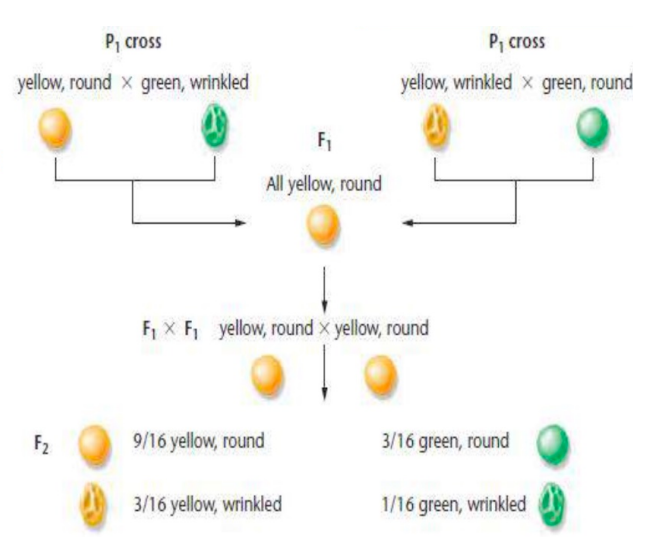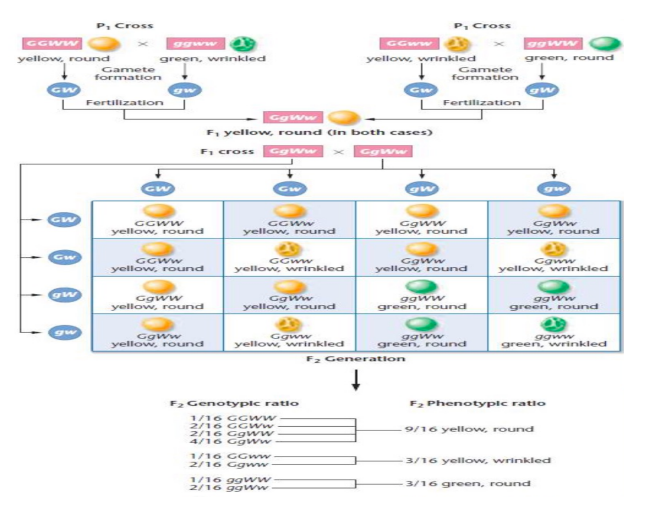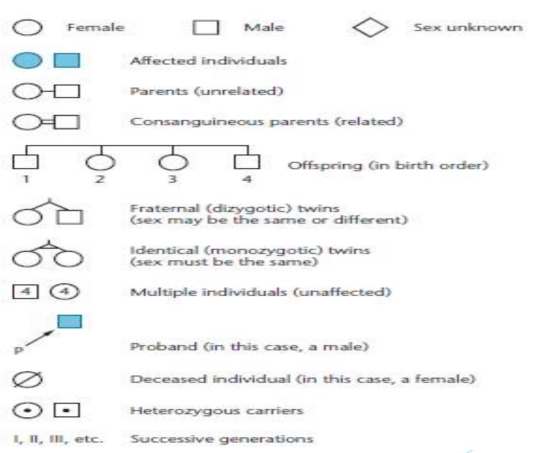CYTOGENETICS: L1 (M)
1/45
Earn XP
Description and Tags
opalite woah oh oh oh oh
Name | Mastery | Learn | Test | Matching | Spaced |
|---|
No study sessions yet.
46 Terms
Gregor Johann Mendel
_____ _____ _____ - Father of Mendelian Genetics
1866 (year he published his groundbreaking paper, Versuche über Pflanzenhybriden (Experiments on Plant Hybridization), which laid the foundation for modern genetics.)
major postulates of transmission genetics garden pea (Pisum sativum)
discrete units of inheritance exist and predicted their behavior during the formation of gametes (elementen)
Mendel’s postulates were accepted as the basis for the study of what is known as transmission genetics.
Garden Pea - easy to grow and hybridize artificially
1866
Gregor Johann Mendel - Father of Mendelian Genetics
____ (year he published his groundbreaking paper, Versuche über Pflanzenhybriden (Experiments on Plant Hybridization), which laid the foundation for modern genetics.)
major postulates of transmission genetics garden pea (Pisum sativum)
discrete units of inheritance exist and predicted their behavior during the formation of gametes (elementen)
Mendel’s postulates were accepted as the basis for the study of what is known as transmission genetics.
Garden Pea - easy to grow and hybridize artificially
Versuche über Pflanzenhybriden
Gregor Johann Mendel - Father of Mendelian Genetics
1866 (year he published his groundbreaking paper, _____ _____ _____ (Experiments on Plant Hybridization), which laid the foundation for modern genetics.)
major postulates of transmission genetics garden pea (Pisum sativum)
discrete units of inheritance exist and predicted their behavior during the formation of gametes (elementen)
Mendel’s postulates were accepted as the basis for the study of what is known as transmission genetics.
Garden Pea - easy to grow and hybridize artificially
Experiments on Plant Hybridization
Gregor Johann Mendel - Father of Mendelian Genetics
1866 (year he published his groundbreaking paper, Versuche über Pflanzenhybriden (_____ __ _____ _____), which laid the foundation for modern genetics.)
major postulates of transmission genetics garden pea (Pisum sativum)
discrete units of inheritance exist and predicted their behavior during the formation of gametes (elementen)
Mendel’s postulates were accepted as the basis for the study of what is known as transmission genetics.
Garden Pea - easy to grow and hybridize artificially
Pisum sativum
Gregor Johann Mendel - Father of Mendelian Genetics
1866 (year he published his groundbreaking paper, Versuche über Pflanzenhybriden (Experiments on Plant Hybridization), which laid the foundation for modern genetics.)
major postulates of transmission genetics garden pea (_____ _____)
discrete units of inheritance exist and predicted their behavior during the formation of gametes (elementen)
Mendel’s postulates were accepted as the basis for the study of what is known as transmission genetics.
Garden Pea - easy to grow and hybridize artificially
Elementen
Gregor Johann Mendel - Father of Mendelian Genetics
1866 (year he published his groundbreaking paper, Versuche über Pflanzenhybriden (Experiments on Plant Hybridization), which laid the foundation for modern genetics.)
major postulates of transmission genetics garden pea (Pisum sativum)
discrete units of inheritance exist and predicted their behavior during the formation of gametes ()
Mendel’s postulates were accepted as the basis for the study of what is known as transmission genetics.
Garden Pea - easy to grow and hybridize artificially
Garden Pea
Gregor Johann Mendel - Father of Mendelian Genetics
1866 (year he published his groundbreaking paper, Versuche über Pflanzenhybriden (Experiments on Plant Hybridization), which laid the foundation for modern genetics.)
major postulates of transmission genetics garden pea (Pisum sativum)
discrete units of inheritance exist and predicted their behavior during the formation of gametes (elementen)
Mendel’s postulates were accepted as the basis for the study of what is known as transmission genetics.
_____ _____ - easy to grow and hybridize artificially
Monohybrid Cross
One pair of contrasting traits
P1
Parental Generation
F1 (First Filial Generation)
Offspring of the Parental Generation
F2 (Second Filial Generation)
Offspring of the F1 Generation
Traits
Kinds of _____
Dominant - expressed gene
Recessive - masked gene
Homozygous gene - same allele (TT / tt)
Heterozygous - combination of dominant and recessive alleles (Tt)
Dominant
Kinds of Traits
_____ - expressed gene
Recessive - masked gene
Homozygous gene - same allele (TT / tt)
Heterozygous - combination of dominant and recessive alleles (Tt)
Recessive
Kinds of Traits
Dominant - expressed gene
_____ - masked gene
Homozygous gene - same allele (TT / tt)
Heterozygous - combination of dominant and recessive alleles (Tt)
Homozygous gene
Kinds of Traits
Dominant - expressed gene
Recessive - masked gene
_____ _____ - same allele (TT / tt)
Heterozygous - combination of dominant and recessive alleles (Tt)
Heterozygous
Kinds of Traits
Dominant - expressed gene
Recessive - masked gene
Homozygous gene - same allele (TT / tt)
_____ - combination of dominant and recessive alleles (Tt)
Unit Factors in Pairs
Mendel’s First Three Postulates
_____ _____ __ _____: Genetic characters are controlled by unit factors that exist in pairs in individual organisms.
Dominance/Recessiveness: When two unlike unit factors responsible for a single character are present in a single individual, one unit factor is dominant to the other, which is said to be recessive.
Segregation: During the formation of gametes, the paired unit factors separate or segregate randomly so that each gamete receives one or the other with equal likelihood.
Dominance/Recessiveness
Mendel’s First Three Postulates
Unit Factors in Pairs: Genetic characters are controlled by unit factors that exist in pairs in individual organisms.
_____/_____: When two unlike unit factors responsible for a single character are present in a single individual, one unit factor is dominant to the other, which is said to be recessive.
Segregation: During the formation of gametes, the paired unit factors separate or segregate randomly so that each gamete receives one or the other with equal likelihood.
Segregation
Mendel’s First Three Postulates
Unit Factors in Pairs: Genetic characters are controlled by unit factors that exist in pairs in individual organisms.
Dominance/Recessiveness: When two unlike unit factors responsible for a single character are present in a single individual, one unit factor is dominant to the other, which is said to be recessive.
_____: During the formation of gametes, the paired unit factors separate or segregate randomly so that each gamete receives one or the other with equal likelihood.
Postulates
Mendel’s First Three _____
Unit Factors in Pairs: Genetic characters are controlled by unit factors that exist in pairs in individual organisms.
Dominance/Recessiveness: When two unlike unit factors responsible for a single character are present in a single individual, one unit factor is dominant to the other, which is said to be recessive.
Segregation: During the formation of gametes, the paired unit factors separate or segregate randomly so that each gamete receives one or the other with equal likelihood.
Genotype
Terminology:
_____: the genetic constitution of an individual (PP, Pp, pp)
Phenotype: the outward appearance of an individual (purple, white)
Dominant phenotype: the phenotype seen when two alternative alleles are present together (Pp: purple)
Dominant allele: the form of the gene that is expressed when two alternative alleles are present together (P>p)
Recessive allele: the form of the gene that is not expressed when two alternative alleles are present together.
Recessive phenotype: the phenotype that is only seen when two identical alleles are found together (pp: white)
Homozygous: having two identical alleles (PP or pp)
Heterozygous: having two different alleles (Pp)
Phenotype
Terminology:
Genotype: the genetic constitution of an individual (PP, Pp, pp)
_____: the outward appearance of an individual (purple, white)
Dominant phenotype: the phenotype seen when two alternative alleles are present together (Pp: purple)
Dominant allele: the form of the gene that is expressed when two alternative alleles are present together (P>p)
Recessive allele: the form of the gene that is not expressed when two alternative alleles are present together.
Recessive phenotype: the phenotype that is only seen when two identical alleles are found together (pp: white)
Homozygous: having two identical alleles (PP or pp)
Heterozygous: having two different alleles (Pp)
Dominant phenotype
Terminology:
Genotype: the genetic constitution of an individual (PP, Pp, pp)
Phenotype: the outward appearance of an individual (purple, white)
_____ _____: the phenotype seen when two alternative alleles are present together (Pp: purple)
Dominant allele: the form of the gene that is expressed when two alternative alleles are present together (P>p)
Recessive allele: the form of the gene that is not expressed when two alternative alleles are present together.
Recessive phenotype: the phenotype that is only seen when two identical alleles are found together (pp: white)
Homozygous: having two identical alleles (PP or pp)
Heterozygous: having two different alleles (Pp)
Dominant allele
Terminology:
Genotype: the genetic constitution of an individual (PP, Pp, pp)
Phenotype: the outward appearance of an individual (purple, white)
Dominant phenotype: the phenotype seen when two alternative alleles are present together (Pp: purple)
_____ _____: the form of the gene that is expressed when two alternative alleles are present together (P>p)
Recessive allele: the form of the gene that is not expressed when two alternative alleles are present together.
Recessive phenotype: the phenotype that is only seen when two identical alleles are found together (pp: white)
Homozygous: having two identical alleles (PP or pp)
Heterozygous: having two different alleles (Pp)
Recessive allele
Terminology:
Genotype: the genetic constitution of an individual (PP, Pp, pp)
Phenotype: the outward appearance of an individual (purple, white)
Dominant phenotype: the phenotype seen when two alternative alleles are present together (Pp: purple)
Dominant allele: the form of the gene that is expressed when two alternative alleles are present together (P>p)
_____ _____: the form of the gene that is not expressed when two alternative alleles are present together.
Recessive phenotype: the phenotype that is only seen when two identical alleles are found together (pp: white)
Homozygous: having two identical alleles (PP or pp)
Heterozygous: having two different alleles (Pp)
Recessive phenotype
Terminology:
Genotype: the genetic constitution of an individual (PP, Pp, pp)
Phenotype: the outward appearance of an individual (purple, white)
Dominant phenotype: the phenotype seen when two alternative alleles are present together (Pp: purple)
Dominant allele: the form of the gene that is expressed when two alternative alleles are present together (P>p)
Recessive allele: the form of the gene that is not expressed when two alternative alleles are present together.
_____ _____: the phenotype that is only seen when two identical alleles are found together (pp: white)
Homozygous: having two identical alleles (PP or pp)
Heterozygous: having two different alleles (Pp)
Homozygous
Terminology:
Genotype: the genetic constitution of an individual (PP, Pp, pp)
Phenotype: the outward appearance of an individual (purple, white)
Dominant phenotype: the phenotype seen when two alternative alleles are present together (Pp: purple)
Dominant allele: the form of the gene that is expressed when two alternative alleles are present together (P>p)
Recessive allele: the form of the gene that is not expressed when two alternative alleles are present together.
Recessive phenotype: the phenotype that is only seen when two identical alleles are found together (pp: white)
_____: having two identical alleles (PP or pp)
Heterozygous: having two different alleles (Pp)
Heterozygous
Terminology:
Genotype: the genetic constitution of an individual (PP, Pp, pp)
Phenotype: the outward appearance of an individual (purple, white)
Dominant phenotype: the phenotype seen when two alternative alleles are present together (Pp: purple)
Dominant allele: the form of the gene that is expressed when two alternative alleles are present together (P>p)
Recessive allele: the form of the gene that is not expressed when two alternative alleles are present together.
Recessive phenotype: the phenotype that is only seen when two identical alleles are found together (pp: white)
Homozygous: having two identical alleles (PP or pp)
_____: having two different alleles (Pp)
Punnett Square
_____ _____
Named after Reginald C. Punnett.
The vertical column represents those of the female parent, and the horizontal row represents those of the male parent. This process thus lists all possible random fertilization events.
The genotypes and phenotypes of all potential offspring are ascertained
Reginald C. Punnett.
Punnett Squares
Named after _____ _ _____
The vertical column represents those of the female parent, and the horizontal row represents those of the male parent. This process thus lists all possible random fertilization events.
The genotypes and phenotypes of all potential offspring are ascertained
Female
Punnett Squares
Named after Reginald C. Punnett.
The vertical column represents those of the _____ parent, and the horizontal row represents those of the male parent. This process thus lists all possible random fertilization events.
The genotypes and phenotypes of all potential offspring are ascertained
Male
Punnett Squares
Named after Reginald C. Punnett.
The vertical column represents those of the female parent, and the horizontal row represents those of the ____ parent. This process thus lists all possible random fertilization events.
The genotypes and phenotypes of all potential offspring are ascertained
Testcross
The _____: One Character
To distinguish the genotype, Mendel devised the testcross method.
The organism expressing the dominant phenotype, but of unknown genotype, is crossed to a known homozygous recessive individual.
Testcross Method
The Testcross: One Character
To distinguish the genotype, Mendel devised the _____ _____.
The organism expressing the dominant phenotype, but of unknown genotype, is crossed to a known homozygous recessive individual.
Homozygous Recessive
The Testcross: One Character
To distinguish the genotype, Mendel devised the testcross method.
The organism expressing the dominant phenotype, but of unknown genotype, is crossed to a known _____ _____ individual.
Dihybrid Cross
Mendel’s _____ _____ Generated a Unique F2 Ratio
Such a cross, involving two pairs of contrasting traits, is a _____ _____, or two-factor cross.
The F1 offspring will all be yellow and round. It is therefore apparent that yellow is dominant to green and that round is dominant to wrinkled.

Independent Assortment
______ _____
On the basis of similar results in numerous dihybrid crosses, Mendel proposed a fourth postulate called _____ _____.
During gamete formation, segregating pairs of unit factors assort independently of each other.
This postulate stipulates that segregation of any pair of unit factors occurs independently of all others.
As a result of random segregation, each gamete receives one member of every pair of unit factors.
Thus, according to the postulate of independent assortment, all possible combinations of gametes are formed in equal frequency

Trihybrid Cross
The _____ _____ Demonstrates That Mendel’s Principles Apply to Inheritance of Multiple Traits
three pairs of contrasting traits, in what is called a _____ _____, or threefactor cross.
When F1 individuals serve as parents, each produces eight different gametes in equal frequencies.
At this point, we could construct a Punnett square with 64 separate boxes and read out the phenotypes.
Pedigree
_____ Reveal Patterns of Inheritance of Human Traits
The traditional way to study inheritance has been to construct a family tree, indicating the presence or absence of the trait in question for each member of each generation.
Such a family tree is called a _____. By analyzing a _____, we may be able to predict how the trait under study is inherited—for example, is it due to a dominant or recessive allele?
When many _____ for the same trait are studied, we can often ascertain the mode of inheritance.

Autosomal Recessive
_____ _____
If the phenotype associated with a given version of a gene is observed only when an individual has two copies, the allele is said to be _____ _____. The phenotype will be observed only when the individual is homozygous for the allele concerned. An individual with only one copy of the allele will not show the phenotype, but will be able to pass the allele on to subsequent generations. As a result, an individual heterozygous for an autosomal recessive allele is known as a carrier.
Carrier
Autosomal recessive
If the phenotype associated with a given version of a gene is observed only when an individual has two copies, the allele is said to be autosomal recessive. The phenotype will be observed only when the individual is homozygous for the allele concerned. An individual with only one copy of the allele will not show the phenotype, but will be able to pass the allele on to subsequent generations. As a result, an individual heterozygous for an autosomal recessive allele is known as a _____.
Autosomal Dominant
_____ _____
If the phenotype associated with a given version of a gene is observed when an individual has only one copy, the allele is said to be _____ _____. The phenotype will be observed whether the individual has one copy of the allele (is heterozygous) or has two copies of the allele (is homozygous).
Heterozygous or Homozygous
Females (XX) have two copies of each gene on the X chromosome, so they can be _____ or _____ homozygous for a given allele. However, males (XY) will express all the alleles present on the single X chromosome that they receive from their mother, and concepts such as 'dominant' or 'recessive' are irrelevant.
Irrelevant
Females (XX) have two copies of each gene on the X chromosome, so they can be heterozygous or homozygous for a given allele. However, males (XY) will express all the alleles present on the single X chromosome that they receive from their mother, and concepts such as 'dominant' or 'recessive' are _____.
X-Linked Dominant Inheritance
_-_____ _____ _____
As in autosomal _____ inheritance, only one copy of a disease allele on the X chromosome is required for an individual to be susceptible to an X-linked _____ disease.
X-Linked Recessive Inheritance
_-_____ _____ _____
As in autosomal _____ inheritance, two copies of a disease allele on the X chromosome are required for an individual with two X chromosomes (a female) to be affected with an X-linked _____ disease.